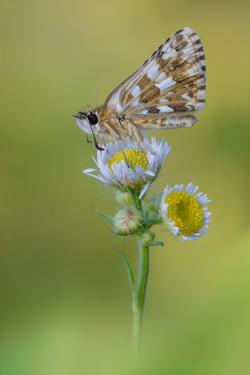Oberthür's Grizzled skipper

Oberthür's Grizzled skipper, Pyrgus armoricanus, has its northern range margin in the southeast part of Sweden, but occurs from northern Africa throughout Europe and into parts of Central Asia. The population trend is variates in Europe, and stable populations only can be found in the Mediterranean countries. The closest population to the Swedish population is located in northwest of Zealand in Denmark and in east Germany (Eliasson, et al., 2005). In Sweden P. armoricanus was found at 15 locations in 2006 (Öckinger, 2006), but are now found in 41 locations. Stable populations recorded in Sweden 2004 - 2014 covered habitat of 47 ha but the butterfly has been detected in a total area of 71 ha. The butterfly is endangered in Sweden (EN). Local population density is associated with connectivity and patch area (Öckinger, 2006) together with the abundance of Filipendula vulgaris, which is the main host plant for the Swedish population for larvae (Eilers, et al., 2013). Helianthemum nummularium is also used as host plant, although more seldom (Eilers, et al., 2013). Potentilla reptans has been documented as host plant in Denmark and Europe (Eliasson, et al., 2005), but it has not been observed in Sweden. Pyrgus armoricanus lives by unfertilized and grazed meadows with a high diversity of flowers. Intensive grazing is an important part of the species reproduction, since the female chose to leave eggs on patches with bare ground. Another important habitat requirement for the oviposition in Sweden is a warm microclimate, preferably a south facing slope (Eilers, et al., 2013). Pyrgus armoricanus has two generations each year in Sweden (Eliasson, et al., 2005).
Responsible for this page:
Director of undergraduate studies Biology
Last updated:
04/27/17
